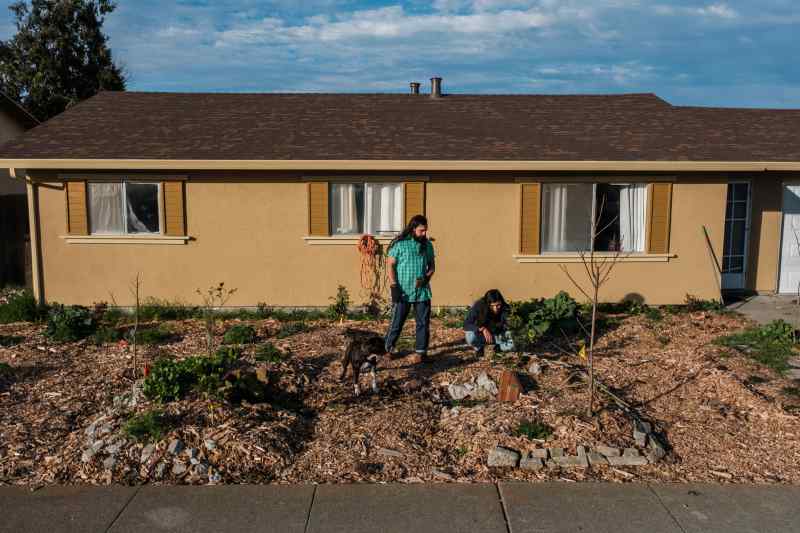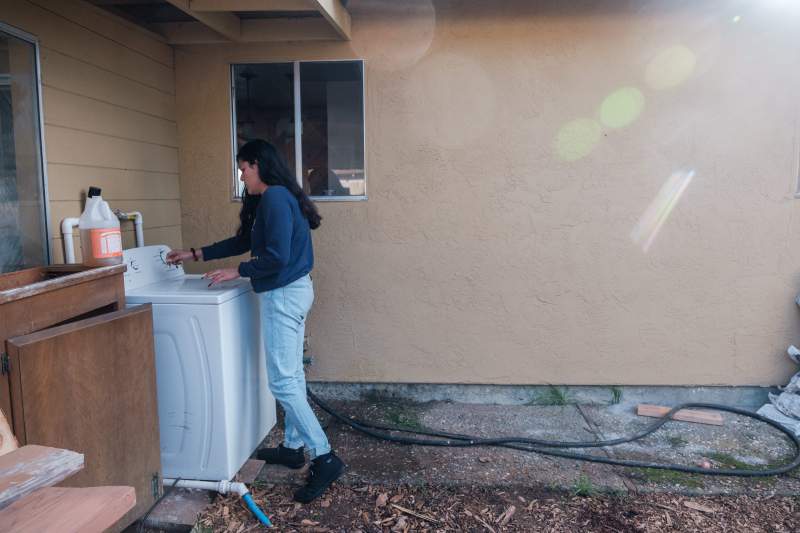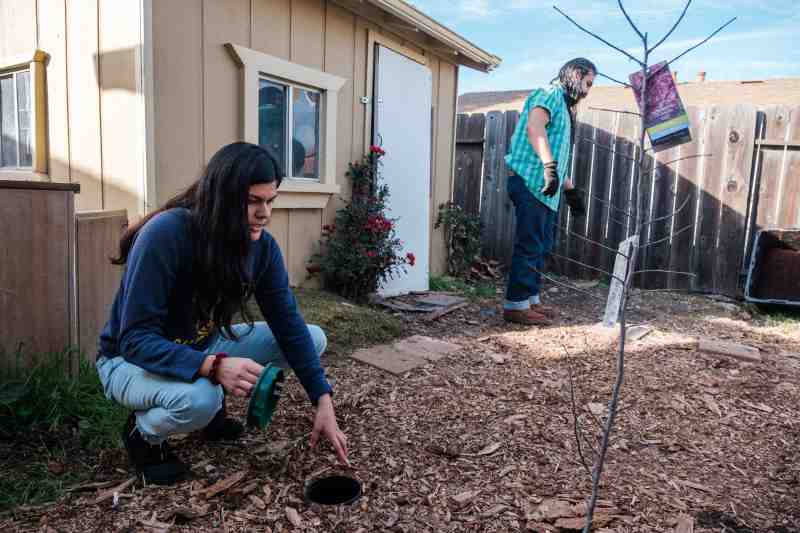More homeowners are turning to greywater systems to recycle what goes down the drain

Jonathan Gómez and Edlin Símental work in the front garden of their home in Suisun City, Ca. They recently installed a laundry-to-landscape irrigation system to reduce their environmental footprint.
10:46 JST, March 29, 2022
Every time you take a shower, brush your teeth or do a load of laundry, you’re letting water – one of Earth’s most precious resources – just swirl down the drain. Instead, what if you reclaimed that water and reused it to flush toilets and water the flowers?
Some municipalities, home builders and water-recycling manufacturers are increasingly making that a viable option. In the United States, where the average household uses more than 300 gallons of water a day, one of the greatest untapped resources is greywater. That’s the water that drains from bathroom showers, tubs and sinks, as well as from washing machines. Recycling this discharge won’t make it suitable as drinking water, but it can be reused in multiple ways, cutting a home’s overall water usage by as much as 40 percent by some estimates.
But achieving that goal isn’t so easy: Greywater recycling isn’t allowed in many municipalities, and those that do have detailed ordinances to ensure that it’s handled safely and won’t contaminate the main water lines. What’s more, installing a greywater system in an existing home may involve tearing out drywall and replumbing fixtures, which is both messy and costly.
“In many cases, if you do any major work to your plumbing system, it requires a permit and has to be done by a licensed plumber,” says Bob Rubin, an emeritus professor at North Carolina State University and expert in biological and agricultural engineering. “Several greywater systems on the market have electrical connections that have to be made for the filters and controls,” he adds.
Compelled by a looming water crisis, Tucson is one of a handful of major U.S. cities that mandates builders to include piping for greywater recycling in new homes. In 2019, the city took part in a pilot program with Lennar Homes to install greywater-filtration systems in some homes in two new subdivisions. At no additional cost to the owners, new homes could be equipped with a greywater-filtration unit made by Greyter Water Systems that would treat water captured from showers and bathtubs to a near-potable quality for reuse in toilet flushing. That alone reduces indoor water consumption by about 25 percent, says John Bell, chief commercial officer at Ontario, Canada-based Greyter.
Sarah Almand and her husband opted to include a Greyter system when they purchased a new house in one of the subdivisions for $330,000 in 2019. “I had never heard of a greywater system, but I was really interested,” says Almand, 43, whose family includes two young children. “I like to help out the environment, especially in Arizona, where water is scarce.”
Located in the home’s garage, the filtration unit measures about 2-feet by 2-feet, Almand estimates. Water is captured from the home’s showers and bathtubs and run through a series of filters before it’s returned to toilet tanks for flushing. The recycled greywater looks and smells no different from their tap water, she adds. And because the recycled water is used just for toilet flushing and not for landscaping, she’s not required to use special shampoos, soaps and cleaning supplies to protect grass, trees and plants. As part of its agreement with Tucson Water, Greyter monitors and maintains the system at no extra charge for five years.
When it was first installed, the filtration unit was noisier than the family expected, so a company technician adjusted the unit to dampen the sound. (The company has since made design changes to address sound issues.) And while Almand is happy with the family’s decision to install the greywater system, they probably wouldn’t have gone forward with it if they had to pay $4,500 for the Greyter unit themselves.
Financial incentives increase the likelihood that builders and homeowners will install greywater systems, says Kevin Reidy, senior state water-efficiency specialist with the Colorado Water Conservation Board. In Denver, a $130,000 grant from the conservation board is enabling Greyter to install greywater systems in 25 new Lennar Homes at no additional cost to the owners.
Another Colorado city, Castle Rock, gives builders a 33 percent discount on the tap fee – the charge to hook homes up to the city’s water supply – if they fall below caps on indoor and outdoor water usage. Programs like these “could pave the way for more incentives to make new developments more efficient,” Reidy says. Still, only four Colorado jurisdictions have enacted ordinances so far, Reidy says, which might be holding back widespread use. Some cities are slow to act because they lack the resources to issue permits and conduct inspections.
There are a number of different ways to recycle greywater, the simplest being to capture water in a container before it reaches the drain and carry it outside. Rubin uses this method in the summer to water the flowerbeds in his yard.
Basic systems use the force of gravity and/or an electric pump to take water discharged from clothes washers and divert it to outdoor irrigation lines. Materials typically cost between $150 and $300, and labor ranges from $500 to $2,000, depending on the scope of the work, according to Sustainable Solano, a nonprofit conservation group in Benicia, Calif. The state allows laundry-to-landscape setups in single-family homes without a permit as long as certain guidelines are followed.

Edlin Símental runs a load of laundry in the backyard of her Suisun City, Ca., home. “We wanted to be more sustainable and self-reliant,” she says.

A view of the washing machine and pipes that are a part of the laundry-to-landscape irrigation system at Jonathan Gómez and Edlin Símental’s home in Suisun City, Ca.
Sustainable Solano helped Jonathan Gómez and Edlin Símental add a laundry-to-landscaping setup in their Suisun City, Calif., home in November. The couple, both are 28 years old, purchased their fixer-upper for $330,000 early last year with the goal of making it more eco-friendly. “We wanted to be more sustainable and self-reliant,” says Simental, a training facilitator. “We can find ways to be not so wasteful.”
Their system, funded by the Solano County Water Agency, connects to their washing machine and includes a valve that can either send discharged water to the sewer or be diverted to underground irrigation lines leading to six mulch beds with plants and trees. The couple does two to three loads of laundry per week, and they’re careful to divert discharged water to the sewer when they do wash with bleach, which can harm plants. Since their system is new, it’s too early to calculate any savings on their water bill, which averages about $200 per month.
The system requires very little oversight, says Gómez, who repairs electronics. “Every now and then, I check the hoses and make sure nothing is plugged up. So far, the installation has gone pretty seamlessly. It’s low maintenance – everything is buried and underground,” he says.
Compelled by droughts in California and in her family’s native India, Shreya Ramachandran launched a nonprofit foundation called The Grey Water Project in 2016 to promote greywater recycling. The following year, when she was in eighth grade, Ramachandran persuaded her parents to help her install a laundry-to-landscaping system in their Fremont, Calif., home.
“It’s such an essential drought solution and something we should all be doing more of,” says Ramachandran, now an 18-year-old freshman at Stanford University.
A number of companies make more elaborate greywater-recycling systems that can filter discharged water and, when necessary, store it briefly in a holding tank before use in irrigation. Water Wise Group Inc. is a wholesale distributor based in Paso Robles, Calif., makes a unit that sells for $729, plus shipping. Installation costs vary, depending on whether the home has a basement or crawl space for easy access to plumbing, says Remy Sabiani, founder of Water Wise Group.
Reducing overall water consumption is the main reason customers install a Water Wise unit, Sabiani says. But many of his rural clients cite an added benefit: The system diverts greywater – up to 40,000 gallons a year – away from their septic systems. “Your [septic] tank may be too small for the amount of water that goes into it. Replacing it with a bigger tank can easily cost $15,000.” A Water Wise system spares homeowners that expense, he says.
Because it can harbor dangerous pathogens, greywater isn’t without its risks. Rubin, the water expert, says homeowners shouldn’t recycle water from kitchen sinks and dishwashers. “People wash chicken, beef, etcetera, and there could be salmonella or toxic E.coli in the water.”
But even bathroom shower and sink water contains microbial matter, so greywater systems shouldn’t store the discharge in tanks for long periods of time, he adds. This is also why untreated greywater shouldn’t be used for sprinklers or washing the car – the aerosol makes the pathogens airborne.
“I believe firmly that people should follow their [city] code,” Rubin says. “All too often, things get installed without going through building officials. Don’t be a greywater guerrilla.”
Going Grey: Some things to ask when considering a greywater system

Edlin Símental checks the irrigation system in the backyard or her Suisun City, Ca., home. “We wanted to be more sustainable and self-reliant,” she says.
What are the codes in my municipality?
Find out if greywater recycling is allowed before installing a system and, if so, get a permit if it’s required. Otherwise, unpermitted work may be an issue when it comes time to sell your home. Municipal codes vary widely, and you’ll be asked to provide specifications on your system that indicate how the water will be captured, stored and disseminated.
What is the scope of work that will be done?
Assess your landscape’s watering needs first, then install a system that captures the right amount of water to meet them. But be mindful that in an existing home, capturing greywater from multiple drains may require tearing into floors and walls, making it cost prohibitive.
Are there financial incentives to help offset the cost?
Maybe. Some states and municipalities offer rebates or discounts to homeowners who install permanent greywater-recycling systems. Tucson, Ariz., for example, reimburses 50 percent of qualifying costs, up to $1,000. Check with your local water utility.
What kind of filtration is used to recycle greywater?
Basic laundry-to-landscaping systems may only filter out solid particles that could clog irrigation pipes. The most advanced systems comply with American National Standards (NSF-350 and NSF-350-1). These require recycling systems to filter out harmful microbial matter and keep greywater at or below acceptable levels for turbidity, chlorination, suspended solids, E. coli and dissolved oxygen.
Is my plumber qualified to install a recycling system?
Plumbing codes developed by the International Association of Plumbing and Mechanical Officials and the International Code Council include standards for greywater reuse to prevent backflow contamination of potable water and divert excess greywater to sewage lines among other things.
Will I need to use special soaps, shampoos and cleaning agents?
Yes, if your system is used to water landscaping. Some soaps and cleaners contain salt, bleach and other chemicals that are harmful to plants.
"News Services" POPULAR ARTICLE
-

American Playwright Jeremy O. Harris Arrested in Japan on Alleged Drug Smuggling
-

Japan’s Nikkei Stock Average as JGB Yields, Yen Rise on Rate-Hike Bets
-

Japan’s Nikkei Stock Average Licks Wounds after Selloff Sparked by BOJ Hike Bets (UPDATE 1)
-

Japan’s Nikkei Stock Average Buoyed by Stable Yen; SoftBank’s Slide Caps Gains (UPDATE 1)
-

Japanese Bond Yields Zoom, Stocks Slide as Rate Hike Looms
JN ACCESS RANKING
-

Tokyo Economic Security Forum to Hold Inaugural Meeting Amid Tense Global Environment
-

Keidanren Chairman Yoshinobu Tsutsui Visits Kashiwazaki-Kariwa Nuclear Power Plant; Inspects New Emergency Safety System
-

Imports of Rare Earths from China Facing Delays, May Be Caused by Deterioration of Japan-China Relations
-

University of Tokyo Professor Discusses Japanese Economic Security in Interview Ahead of Forum
-

Japan Pulls out of Vietnam Nuclear Project, Complicating Hanoi’s Power Plans
























